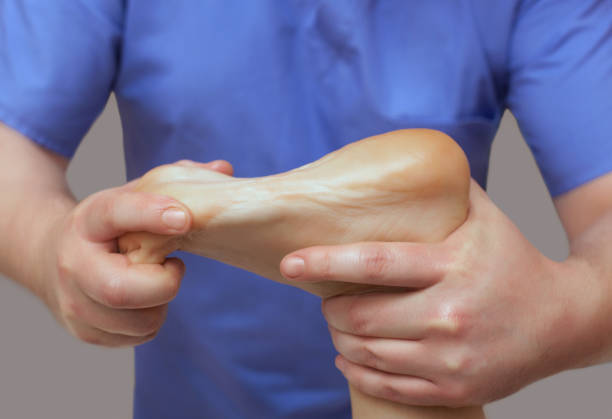The good news is that most cases of plantar fasciitis improve with conservative treatment.
A physical therapist can show you exercises to stretch the plantar fascia and Achilles tendon, strengthen your lower leg muscles, and help stabilize the foot. Icing the heel several times a day and wearing night splints can also relieve pain.

Stretching
The pain of plantar fasciitis comes from inflammation or tiny tears in the thick band of fibrous tissue that runs from your heel bone to your toes. It’s a painful condition that often flares up first thing in the morning or after long periods of sitting or standing, making it difficult to get around without a lot of discomfort.
If you suffer from plantar fasciitis, a few simple home treatments can help reduce symptoms and speed healing. These include stretching your foot, calf, and Achilles tendon; using a foam roller or other massage device to improve foot circulation; wearing shoes with good arch support; icing; and avoiding high impact activities like running on hard surfaces.
If these measures don’t provide enough relief, your doctor may recommend a cortisone injection to decrease pain and swelling. Other procedures that can help decrease pain and promote healing include dry needling, an alternative medicine technique that involves inserting needles into your skin to relieve muscle pain; extracorporeal shock wave therapy, which uses shock waves to increase blood flow to the affected area; and platelet-rich plasma (PRP) injections, in which a concentrated portion of your own blood is injected into injured tissues to promote healing.
Ice
Icing is a cheap and easy way to reduce heel pain. It helps to relieve inflammation and speed up the healing process. Ice also tightens blood vessels and brings down swelling.
Ice the bottom of your foot for about 20 minutes several times a day or as needed. You can use a plastic bag filled with water, a frozen water bottle, or even just a regular ice pack. You can also place a frozen therapy ball on the bottom of your foot or on a chair and roll it back and forth over the fascia. This works great after stretching, as it massages the fascia and relieves tension.
Other home treatment options include nonsteroidal anti-inflammatory drugs (NSAIDs), which numb pain and ease inflammation. You can also try putting arch supports in your shoes, wearing cushioned shoe inserts like Heel Seats, using a night splint to keep the plantar fascia flexed while you sleep and doing exercises to strengthen the muscles of the foot and ankle. These can improve your flexibility and help prevent the condition from coming back.

Rest
Usually, people with plantar fasciitis feel pain in the arch of the foot when they walk. The pain is most intense when they start to move after resting, such as right after waking up or when climbing stairs. Usually, the pain fades as they continue to walk.
If home treatments, such as icing and stretching, don’t ease the pain, your doctor may suggest plantar fasciitis treatment in Perth. These include nonsteroidal anti-inflammatory medication to reduce inflammation and swelling; and physical therapy. Your physical therapist will teach you exercises that stretch the plantar fascia and Achilles tendon. They can also show you how to modify or avoid activities that irritate your plantar fasciitis.
Other treatments to try include ultrasound, a device that sends sound waves into the tissue, and TENS, which uses electric current to improve blood flow and interrupt the body’s signals for pain. Another option is platelet-rich plasma (PRP) injection, in which the doctor injects your own blood into the injured tissue to promote healing. Some people also benefit from dry needling, a technique similar to acupuncture that involves inserting needles into the skin.
Orthotics
Orthotics, such as silicone heel cup inserts that cushion and elevate the heels while you walk, take pressure off the plantar fascia. These devices are available over-the-counter and can be very effective. Custom orthotics can improve your quality of life by easing pain and improving function. They can also help if you have flat feet, high arches, or problems with pronation.
Your doctor or physical therapist can teach you how to stretch and massage your foot and calf muscles. This can reduce pain and speed healing.
You may also get a cortisone injection to reduce inflammation and pain. This treatment usually provides several months of relief.
When noninvasive treatments don’t provide enough relief, your doctor may recommend a procedure to break up and remove scar tissue from the plantar fascia. This is called extracorporeal pulse activation technology, or EPAT. It is a noninvasive, in-office procedure. During EPAT, your provider uses an ultrasound imaging system to locate the damaged fascia tissue and makes a small incision to break up the scar tissue. Your doctor can then suction out the tissue.
Massage
There’s nothing like a painful heel that keeps you from getting out and moving your body around. While you may be able to find short term relief with ice and other at-home treatments, it’s best to see a physical therapist for long lasting results.
One of the most effective plantar fasciitis treatments is massage. It can help break down scar tissue and improve fascia mobility. This in turn will relieve pain both during a massage session and afterward.
A massage therapist can also provide you with techniques for self-massage at home. They can show you how to use a tennis ball or golf ball to massage the bottom of your feet. Using this technique can help reduce pain and prevent your condition from returning.
Plantar Fasciitis is a common foot injury that can be treated at home with a few simple steps. By following these tips, you can reduce pain and get back to your normal life activities. Just remember that it’s important to talk to a physical therapist for help with this condition so you can avoid re-injury and have a successful recovery!




